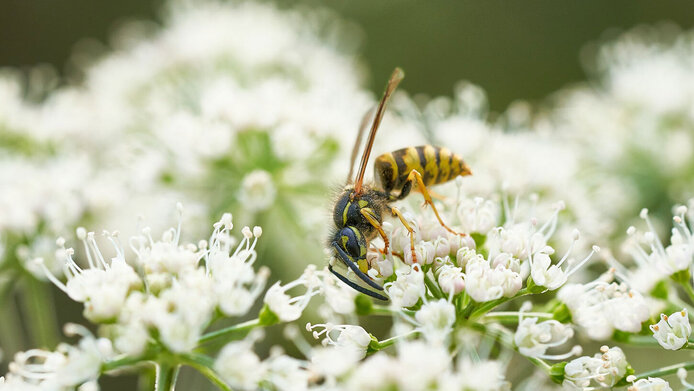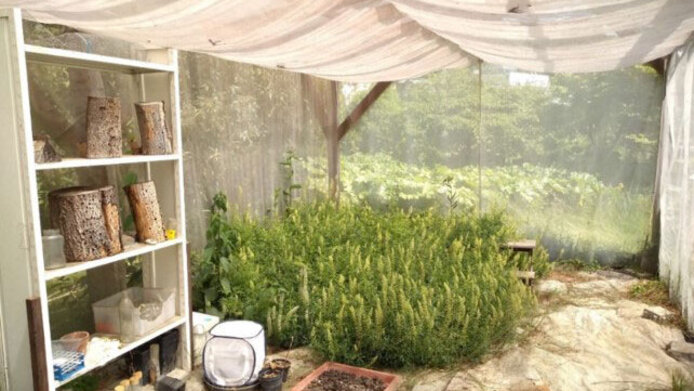Global warming disrupts the relationship between plants and pollinators

Without the scent of roses, lilacs and lilies of the valley, our olfactory world would be a lot poorer. The scent of flowers is not primarily a chemical signal to humans, however, but to their pollinators. And many crops indeed depend on insects for pollination. Therefore, if the flower-pollinator interaction is impaired by global warming, this will also affect the harvest yield. In his FWF-supported project under the Lise-Meitner funding track, entomologist Guaraci Duran Cordeiro from the University of São Paulo investigated how global warming affects the relationship between three crops and three pollinators. He used the ‘flight cage’ of the University of Salzburg's Botanical Garden, an open-air laboratory enclosed by netting for controlled pollination experiments, to compare the attraction of strawberry and buckwheat at physiologically optimal temperatures with the modified composition of the floral scent at five degrees of warming.
Decoding the enticing scent
Principal investigator Cordeiro selected crop plants from different plant families for the experiments in the FWF project: strawberry (Rosaceae), buckwheat (Polygonaceae) and oilseed rape (Brassicaceae). The three pollinators were the European honey bee (Apis mellifera), the buff-tailed bumblebee (Bombus terrestris), and the red mason bee (Osmia bicornis), all from the Hymenoptera group. Cordeiro cooperated with Stefan Dötterl, head of the plant ecology working group and the Botanical Garden in Salzburg. In the course of many methodological steps the researchers explored the influence of a strong climate change scenario of five degrees of warming on the chemical plant-pollinator communication. Behavioural observations in the flight cage in sunny weather were only the final step in the process.
First, the researchers captured the intensity and composition of the floral scent for all three crops for the two scenarios – “optimal” and “plus five degrees” – and then analysed the chemical composition by means of gas chromatography and mass spectrometry. “Floral scents can be very complex and involve up to 200 chemical components. Oilseed rape and buckwheat have around 20 components, the scent of strawberry blossoms only five,” reports Cordeiro. The team then synthetically reconstructed the flower scents from both scenarios and tested them on the antennae of the pollinating insects. Electrodes can be used to find out whether the scent mixture triggers a physiological reaction. The antennae of insects react most strongly to the main components of the flower scents. This suggests that the fewer components a flower scent has and the more sensitive the reaction of its main components to heat, the poorer its chances of pollination will be with global warming.
Only two out of three
The findings showed that the chemical signals of oilseed rape remained unaffected even in the increased temperature scenario. Buckwheat showed significantly reduced scent intensity in the “plus five degrees” scenario, but the composition of the chemical signal remained identifiable for pollinators. Only the strawberries performed poorly in the climate change scenario, as they no longer produce any detectable floral scent at all in the “plus five degrees” simulation, which means they might not be found at all by bees, bumblebees and other insects. Of course, visual stimuli are also important for the interaction between pollinators and flowers, but on its own this aspect is often not enough to attract the insects.
The biologist spent many hours in the flight cage observing how the three pollinating insects reacted to his artificial flowers made of paper and keeping a record of the chemical attraction. In each case he used three types: the scent mixture for “optimal” in comparison with “altered by warming”, with a solvent used as a control. Many questions remain unanswered about the interactions between bees and flowers, such as the effect of earlier flowering times in warmer conditions and whether there are thresholds for scent perception. But this project has shown for the first time that the interaction between plants and pollinators is disturbed under climate change conditions, as insects can no longer perceive some crops in the way they used to.
Guaraci Duran Cordeiro acquired his PhD in entomology at the University of São Paulo in Brazil, where he also did his postdoctoral research in chemical ecology on the effect of volatile floral scents on nocturnal bees. At the University of Salzburg he investigated the effects of global warming on crop floral scents and chemical interactions between plants and their pollinators. He is currently conducting research on pollinator-plant interaction, monitoring and making an inventory of pollinators and bee biology. The project “Climate change impact on crop plant-pollinator communication” (2019–2021) received some EUR 160,000 in funding from the Austrian Science Fund FWF.
Publications
Cordeiro GD, Liporoni R., Caetano CA, Krug Ch.: Nocturnal Bees as Crop Pollinators, in: Agronomy 2021
Cordeiro GD, Dötterl S.: Global warming impairs the chemical attractiveness to pollinators, submitted in: Climatic Change (Preprint)







